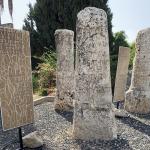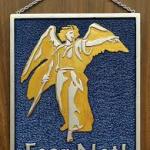I blogged previously about what I learned about cherry-picking from the Bible by actually picking cherries. Today I’ll do something similar in relation to words attributed to John the Baptist in Luke 3:9 and Matthew 3:10. John says the ax is already at the root of the tree, and unfruitful trees will be cut down. You may consider this part of my series “in the footsteps of John the Baptist” although this insight occurred as I was working in my own garden, seeking to bring down a very small and recent tree that was growing at an angle and in a location that together posed the potential for problems later on. This work was relatively easy but not without effort being involved even so. This was much, much less strenuous than the process of bringing down a larger tree. We have some experience with that, but not doing the work ourselves. When there’s a large old tree near one’s house, sooner or later it will either be cut down or will fall and damage the house. We decided not to wait and hired a company. We did not pay extra to have the stump removed when we’ve had this work done, and such stumps are still there. I cannot help thinking about that in relation to John’s mention of the axe being at the root of the tree. I can’t make much of a dent in a large maple stump with a chain saw, never mind an axe.
My main takeaway from thinking about John the Baptist while working in my yard is that I am even less persuaded that John’s apocalyptic vision was of God intervening to bring about change without human assistance. If the “one who is to come” was a person, someone who was to arise from within his circle of followers, and not a reference to God (as seems likely to me, although interpreters disagree about this) then John was preparing his group to bring about judgment and radical change, not merely to witness it as God did all the work miraculously. There would likely be a miraculous sign of some dramatic sort to confirm that the time had arrived. But people would need to prepare for that moment, and they would need to act when it arrived.
This may be the reason for John’s question as to whether Jesus was this figure. I do get the impression that John viewed Jesus as his right-hand man and likely successor in the movement at some point. I also get the impression that John began to doubt his earlier thinking about Jesus, most likely because Jesus was not enacting the kind of judgment that John preached about and was hoping for. Jesus took up John’s imagery of bearing fruit, but does not appear to have used it in precisely the same way or with precisely the same implications as his mentor.
These are the kinds of things I think about as a New Testament scholar when working in the yard. I imagine that some people will do yard work hoping to put their jobs out of their minds for a while. I’m happy to have the privilege of a job in which I do what I love, and I think about the questions that I research as part of my job all the time and not just during regular business hours.
What are your thoughts on John’s reference to the axe being at the root of the tree?
In another instance of online serendipity, Steve Wiggins also blogged about trees.
So did Brent Nongbri—more specifically about dendrochronology.
Also check out James Tabor’s new video about the likelihood that the original version of the Book of Revelation was a Jewish, non-Christian work.
https://www.youtube.com/watch?v=FITFqSzwn0o
See as well his follow-up blog post responding to an early response to his video…
https://jamestabor.com/am-i-damned-forever-for-thinking-that-the-book-of-revelation-has-been-interpolated-by-christians/













